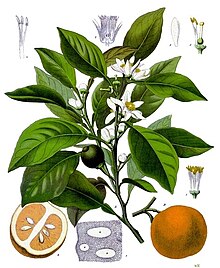Orange oil
Orange oil is also known as orange peel oil ( Latin Aurantii dulcis Aetheroleum ). There are two main types of orange oil:
- Orange oil, sweet
- Orange oil, bitter
Orange oil, sweet
| safety instructions | |||||||
|---|---|---|---|---|---|---|---|
| Surname |
Orange oil, sweet |
||||||
| CAS number |
8008-57-9 |
||||||
|
|||||||
| Toxicological data | |||||||
Orange oil is obtained by cold pressing the ripe fruit peels of the orange variety Citrus sinensis . The fruit peels are a by-product of orange juice production and are produced in large quantities. Orange oil is by far the most widely produced essential oil, the world annual production is around 20,000 tons (year 2002). In 2001 Germany imported over 2,000 tons of orange oil. Along with clove leaf oil and eucalyptus oil, it is one of the most affordable essential oils. Brazil is by far the most important production location for orange oil, along with California , Florida and Sicily .
Chemical ingredients and physical properties
Orange oil is a yellow to reddish-yellow liquid. The density is 0.843 g · cm −3 . The (+) - lime is the main component of orange oil with over 90%. In addition, there are the aldehydes octanal and decanal , sinensal as well as octyl and nerylacetate . The latter give the orange oil its aroma. The ester content, which fluctuates depending on the growing region, has a strong influence on the sales price.
application areas
Orange oil is mainly used to flavor beverages and confectionery and to perfume household products, as well as in biological wood preservatives and paint thinners. It is also the main component of many label removers. It is also very popular as an aroma oil in fragrance lamps for room scenting. The orange oil has an irritant, allergic and phototoxic effect on the skin , so it is better not to use it on the skin.
Orange oil, bitter
| safety instructions | ||||||||||
|---|---|---|---|---|---|---|---|---|---|---|
| Surname |
Orange oil, bitter |
|||||||||
| CAS number |
8028-48-6 |
|||||||||
|
||||||||||
| Toxicological data | ||||||||||
Bitter orange oil is obtained from the peel of Citrus aurantium (Sicily, Spain). It has a more tangerine-like scent and a bitter aroma. World production is around 10 tons, and it is used to flavor liqueurs and scented waters.
Application examples technology
The area of application is the same as for turpentine oil . A higher price is offset by a more pleasant smell and a lower allergy potential.
Areas of application are:
- Degreasing of metal parts, for example bicycle chains, gear wheels or ball bearings. For larger parts, the orange oil is rather unsuitable because of the high price.
- Removal of tar, resin and oil stains
- as a brush cleaner as well as for thinning oil paints
- Resin removal from precision mechanical parts such as old watch parts
- as a substitute for turpentine oil in painting
- as a flavoring in food
- for flavoring cosmetics (soap, bath oil, cream)
Hazards
The main component limonene is labeled as irritating to the skin and dangerous for aquatic organisms according to the CLP regulation . Orange peel oil is flammable and must therefore be kept away from sources of ignition and kept tightly closed. It irritates the skin and mucous membranes. Contact should therefore be avoided. Good ventilation must also be provided during work. If it comes into contact with the skin, orange peel oil must be washed off with soap and water. Product residues must be disposed of in the pollutant collection.
There is an allergy potential, but it is much lower than with other terpenes .
Many plastics, especially polyacrylates and painted furniture surfaces, are attacked and come off.
A carcinogenic ( carcinogenic ) effect was observed in male rats . Limonene reacts with α2U globulin , which is not produced by female rats. Humans do not produce the protein, which is why limonene is believed not to be carcinogenic to humans.
swell
- ↑ a b c d e data sheet Orange oil, cold-pressed, Brazil origin at Sigma-Aldrich , accessed on July 29, 2017 ( PDF ).
- ↑ a b Entry on orange peel oils. In: Römpp Online . Georg Thieme Verlag, accessed on June 15, 2014.
- ↑ a b c data sheet orange oil bitter, Italian (PDF) from Carl Roth , accessed on July 29, 2017.
- ^ Daniel R. Dietrich, James A. Swenberg: The Presence of α2u-Globulin Is Necessary for d-Limonene Promotion of Male Rat Kidney Tumors. Cancer Research 51, 3512-3521, 1991.






